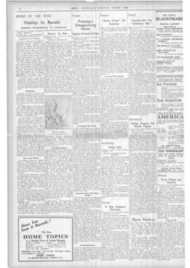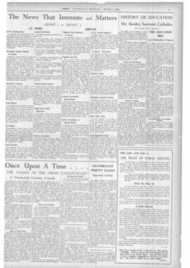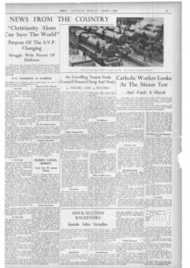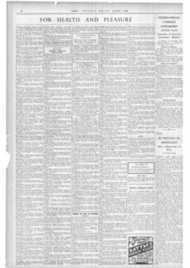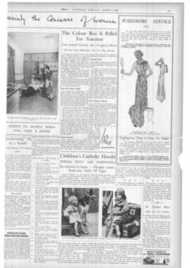Page 14, 7th August 1936
Page 14
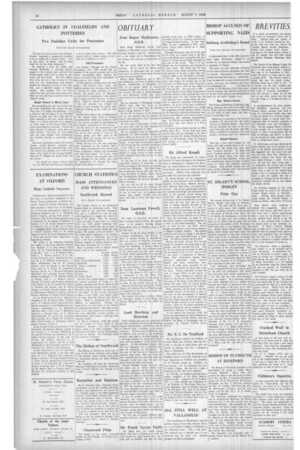
Report an error
Noticed an error on this page?If you've noticed an error in this article please click here to report it.
Tags
Share
Related articles
A Monastic School
Religious Books Today By R. C. Gorman S.j.
;letters From An Abbot
Some Books Of The Week
OBITUARY
Dom Roger Hudleston, O.S.B.
Dom Roger Hudleston, 0.S.B., died suddenly at Downside early on Wednesday morning, August 5, aged 62. He had been for a few weeks rest at Cheltenham, but not feeling well returned to Downside on the 4th.
He was found dead in his bed next morning. By his death, the Abbot and community of Downside lose an exceptional man of ability whose many services cannot be easily supplied.
Robert Roger Hudleston, son of William Hudleston, was born at Hutton John, Penrith, Cumberland, on December 27, 1874, of an ancient family of staunch Catholics (though he was not of the Catholic branch), the same to which belonged Fr. John Hudleston, 0.S.B., who reconciled Charles 11 to the Church on his deathbed.
He was educated at Wellington College, 1888-91, then, after two years, as an articled clerk to a legal firm, he entered Keble College, Oxford, in 1895.
On the 8th of January of the following year he was received into the Church in London and received his First Communion from Pope Leo XIII.
He first came to Downside in 1896 and two years later took the habit making his profession on September 6, 1899.
He was ordained priest at Downside on September 25, 1904, thereafter filling very minor offices in the house, till, in 1916, he was appointed head master of the School at Ealing. A year later he became Chaplain to the Forces and was stationed at Salonica.
From 1924-31 he was in charge of a mission at Little Moldren which he was obliged to resign owing to heart trouble which disabled him from service in that hilly district.
At the time of his death he held the responsible position of .economist to the funds pertaining to the missions or parishes served from Downside. But Dom Roger had conspicuous literary gifts and was for a time the editor of Messrs. Burns, Oates and Washbourne's Orchard series. Last year he published the spiritual message of Abbot Chatman.
His loss will be felt by many friends outside the circle of his own brethren, but hardly by any so grievously as by them, for he was in every way an excellent cornmunity man, regular, careful, and ever ready and able to serve and step into a breach.
Dom Laurence Powell, O.S.B.
We regret to announce the death of Dom Laurence Powell, 0.S.B., who passed away at St. Joseph's Nursing Home, Beaconsfield, early on Monday, Aug. 3, in his 70th year.
Nephew of the late Dean Powell, of the Liverpool Archdiocese, and brother of Dom A. Maurus Powell, of Ampleforth, who was a native of Waterloo, Liverpool, was educated at Ampleforth, and later joined the monastery at Donal, where he was professed in 1889 and ordained priest in the school and was later given charge of studies which appointment he continued to hold after monastery and school were transferred to Woolhampton in 1903.
Two years later he was made sub-prior of the Monastery at Great Maldren where he also had charge of St. Joseph's parish. He returned to Woolhampton as head master of the school in 1911 and in 1916, in succession to the late Dom Paul McCabe, as parish priest of the parish of Wooton Wawen in Warwickshire. There he spent the last twenty years of his life.
Recently, he had been granted the Titular Dignity of Cathedral Prior of Peterborough in recognition of his many and recent services to the monastery.
The funeral took place at Donal Abbey on Thursday, August 6, after Dirge and Solemn Requiem sung by the Abbot of Donai.
Lord Mowbray and Stourton
Three ancient peerages are combined in the titles of nobility held by Lord Mowbray, Segrave and Stourton, who died on July 29 at Allerton Park, Yorkshire, in his seventieth year. The baronies of Mowbray and of Segrave were created in the thirteenth century, and came to be held together by a marriage between the fourth Lord Mowbray and the daughter of the fourth Earl Segrave. In the eighteenth century they fell into abeyance. but a hundred years later the abeyance was terminated. In the case of the barony of Stourton, the creation dates from 1448, but from that year onwards the title has been held continuously in the male line, the peer now dead being the twenty-first baron.
Charles Botolph Joseph Stourton was the eldest son of Alfred Joseph Lord Mowbray, Segrave and Stourton and his wife Mary Margaret née Corbally. For his education he went to the former Catholic school at Woburn Park. He was for about two years a subaltern in the 3rd (Militia) Battalion of the East Yorkshire Regiment. In 1893 the succession came to him in the three peerages and shortly afterwards he married Miss Constable, only child of Thomas Angus Constable of Otley.
It may be recalled that in 1912, Lord Mowbray laid unsuccessful claim to the ancient Earldom of Norfolk, a bestowal, originally, upon the Bigod family; and he claimed to be senior co-heir to a number of baronies, among them Talbot and Howard and Strange de Blackmere.
The new peer is Captain William Marmaduke Stourton, who is in his forty-first year.
Sir Frank Gavan Duffy
The Right Hon. Sir Frank Gavan Duffy, who died in Melbourne on July 29, had passed his eighty-fourth year, yet it was only in October last that he relin
quished active duty as Chief Justice of Australia, proof of a vigorous constitution and long-continued powers. To that high office he was appointed in 1931, after nearly twenty years' service as a High Court Judge.
Although the greater part of his life, and all his work as a lawyer both at the Bar and on the Bench were connected with Australia, Sir Frank Gavan Duffy belonged to this side of the world. That is to say, Dublin was his birthplace, and Stonyhurst his alma mater. His father was the late Sir Charles Gavan Duffy, prominent among Irish patriots of his day, a man who won political office in the Antipodes as Premier of Victoria. The family migration to Australia took Frank, the second son, to the University of Melbourne, where he graduated in law, and in 1874 he was called to the Victorian Bar. He took silk in 1901.
On the Bench, Gavan Duffy displayed an inflexible sincerity which perhaps may have surprised those who had fancied that his own political views would colour his outlook in regard to important constitutional matters. In so far as he was a politician at the time of his appointment as a judge his sympathies tended towards Labour, but on the Bench his political inclinations were always subordinated to his sense of duty in interpreting and applying constitutional law. In 1929 he was made K.C.M.G., and three years later was sworn as a Privy Councillor.
Sir Frank Gavan Duffy married, in 1880, Ellen Mary Torr. Of his three sons who survive him, one has followed in his footsteps in the law : Mr. Justice Charles Gavan Duffy, of the Supreme Court of Victoria, and another is a priest, the Rev. Guy Gavan Duffy.
Sir Alfred Keogh
The King was represented by Lieut.General Sir James Hartigan at the Requiem Mass in Westminster Cathedral last Saturday for Lieut.-General Sir Alfred Keogh, whose death took place in London two days previously, Officers from Aldershot bore the coffin into and from the cathedral.
Sir Alfred Keogh will be remembered chiefly for his important work as DirectorGeneral of the Army Medical Services. That office he filled twice, an unusual distinction. The second appointment enlisted his scientific knowledge and administrative gifts in the national service during the Great War. He so systematised the work of dealing with the wounded that in all possible cases the men were sent for treatment to centres specially devoted to the class of casualty involved. It is only recently that an announcement, giving widespread satisfaction, was made by the Government that civilian sufferers are in future to have the advantage of some of the specialised surgical knowledge acquired as a result of war-time experience. The son of an Irish barrister and R.M., Alfred Keogh was educated in his native country, at Queen's College, Galway. He studied medicine and took his degree at the Royal University, and afterwards came to England. In 1880 he entered the R.A.M.C.
During the South African War he had charge of a hospital, was mentioned in despatches, and was awarded the C.B. The K.C.B. was conferred upon him in 1906; he was promoted G.C.B. in 1917; and in 1918 he was made a Companion of Honour. Many other distinctions, among them honorary doctorates from several English and Scots universities, testified to the high place occupied by Sir Alfred in the esteem of those who knew his work. France bestowed on him the rank of Grand Officer of the Legion of Honour. From Belgium he received the Order of the Crown, and from Serbia the first class of the Order of the White Eagle. From 1921 until 1927, Sir Alfred Keogh was Colonel-Commandant of the A.M.S.
While, therefore, the life work of this distinguished servant of the State is part of the story of the development of medical work in the Army, it should be recorded also that before entering the R.A.M.C., Sir Alfred Keogh worked in civil practice in London, where he was house physician at Brompton Hospital, and an assistant at the Ophthalmic Hospital in Westminster.
At the funeral last Saturday, H.M. the King was represented by Lieut.-General Sir James Hartigan, K.C.B., D.S.O., and that H.R.H. The Duke of Connaught, was represented by Captain Fitzroy Fyers, M.V.O.
Mr. S. C. De Trafford
Mr. Sigismund Cathcart de Trafford, of Croston Hall, near Preston, died last Saturday, at the age of eighty-three, and was buried on Tuesday last after a Requiem Mass at Mawdesley.
The eldest son of John Randolphus de Trafford and his wife Lady Adelaide Cathcart, Sigismund de Trafford was grandson of Sir Thomas Joseph de Trafford, the first baronet. For his education he went to Oscott College. He was for a time a lieutenant in the 14th Foot regiment.
In 1879 Mr. de Trafford married Clementina, daughter of Sir Pyers Mostyn, eighth baronet. Captain G. E. de Trafford, M.C., is a son; another son, Lieutenant R. F. de Trafford, of The King's Own Lancaster Regiment, died of wounds received in the European War. One of his daughters, Lady Edward Seymour, lost her husband in that great conflict, and Miss E. F. de Trafford holds the Royal Red Cross in tribute to her war-time services.
ALL STILL WELL AT VALLADOLID
The Archbishop of Westminster received another telegram from Mgr. Henson, Director of the English College at Valladolid, in the following terms: " All is well, here." The telegram was in Spanish and it is understood that the word " all " includes property as well as personnel.
blog comments powered by Disqus





